Speak directly to the analyst to clarify any post sales queries you may have.
Rare earth metals recycling is accelerating globally as industry leaders seek reliable, sustainable solutions to secure critical materials, respond to regulatory pressures, and optimize circular economy practices. In this evolving market, decision-makers face complex challenges and considerable opportunities for long-term value creation.
Market Snapshot: Rare Earth Metals Recycling Market Size and Trends
The Rare Earth Metals Recycling Market grew from USD 356.91 million in 2024 to USD 400.67 million in 2025. It is expected to continue growing at a CAGR of 11.99%, reaching USD 883.59 million by 2032. This growth reflects increasing adoption in clean energy, electronics, and defense applications, along with a surge in infrastructure investment and regulatory reinforcement across major economies.
Scope & Segmentation of the Rare Earth Metals Recycling Market
This report provides comprehensive analysis by examining market segments, regional dynamics, technology adoption, and end-use industries. The segmentation covers all key market dimensions for precise targeting and informed strategic planning.
- Product Type: Dysprosium, Neodymium, Praseodymium, Terbium
- Process: Hydrometallurgical (Direct Leaching, Ion Exchange, Solvent Extraction); Mechanical (Crushing, Grinding); Pyrometallurgical (Roasting, Smelting)
- Source: Batteries, Catalysts, Permanent Magnets
- End Use Industry: Automotive (Conventional Vehicles, Electric Vehicles, Hybrid Vehicles), Chemical (Catalysts, Phosphors), Defense, Electronics & Electrical (Communication Equipment, Consumer Electronics, Industrial Electronics), Glass & Polishing (Glass Manufacturing, Polishing Powders), Renewable Energy (Solar Panels, Wind Turbine Generators)
- Regions: Americas (North America: United States, Canada, Mexico; Latin America: Brazil, Argentina, Chile, Colombia, Peru), Europe, Middle East & Africa (Europe: United Kingdom, Germany, France, Russia, Italy, Spain, Netherlands, Sweden, Poland, Switzerland; Middle East: United Arab Emirates, Saudi Arabia, Qatar, Turkey, Israel; Africa: South Africa, Nigeria, Egypt, Kenya), Asia-Pacific (China, India, Japan, Australia, South Korea, Indonesia, Thailand, Malaysia, Singapore, Taiwan)
- Key Companies: Umicore SA, Neo Performance Materials Inc., Hitachi Metals, Ltd., Dowa Eco-System Co., Ltd., Lynas Rare Earths Limited, China Northern Rare Earth Group High-Tech Co., Ltd., Shenghe Resources Holding Co., Ltd., Zhejiang Huayou Cobalt Co., Ltd., Energy Fuels Inc., American Battery Technology Company
Key Takeaways: Strategic Insights in Rare Earth Metals Recycling
- Recycling of rare earth metals is attracting heightened strategic interest due to increased demand across electric vehicles, renewable energy, and electronic manufacturing sectors.
- Advanced hydrometallurgical technologies are delivering high-purity yields, while mechanized pretreatment is building process efficiency and consistency across recycling plants.
- Regulatory changes and public-private partnerships are propelling investment in modernized recovery infrastructure and incentivizing end-of-life collection initiatives.
- Automotive, electronics, and renewable energy industries are adapting supply chains and product designs to maximize both the recovery and re-use of critical elements.
- Decentralized supply chains, supported by localized recycling hubs, reduce logistical costs and risk exposure to international market volatility.
- Collaboration among manufacturers, recyclers, and technology developers is catalyzing innovation and facilitating faster deployment of scalable recycling solutions.
Tariff Impact: United States 2025 Import Tariffs and Industry Response
The introduction of tariffs on certain rare earth imports in the United States in 2025 has shifted industry priorities toward domestic recycling. Higher procurement costs have prompted companies to enhance in-house recovery and integrate vertically with upstream partners. These measures are driving improvements in sorting and separation, and fostering a more resilient national supply chain.
Methodology & Data Sources
This research integrates primary interviews with industry executives and technical experts alongside robust secondary sources, including academic publications and corporate disclosures. Insights are validated through expert workshops to ensure depth and practical relevance for the rare earth metals recycling sector.
Why This Report Matters: Decision-Making Value for Senior Leadership
- Enables senior leaders to identify critical growth segments and optimize recycling investments for corporate sustainability and resilience.
- Informs strategic response to evolving regulatory and tariff environments in key global markets.
- Equips teams with actionable intelligence on successful collaboration models, technology partnerships, and value chain integration.
Conclusion
The rare earth metals recycling market is undergoing transformation, guided by technology innovation, regulatory shifts, and collaborative value chain strategies. Senior decision-makers leveraging this intelligence will be positioned to enhance supply security, operational sustainability, and long-term competitiveness.
Additional Product Information:
- Purchase of this report includes 1 year online access with quarterly updates.
- This report can be updated on request. Please contact our Customer Experience team using the Ask a Question widget on our website.
Table of Contents
3. Executive Summary
4. Market Overview
7. Cumulative Impact of Artificial Intelligence 2025
List of Figures
Samples

LOADING...
Companies Mentioned
The key companies profiled in this Rare Earth Metals Recycling market report include:- Umicore SA
- Neo Performance Materials Inc.
- Hitachi Metals, Ltd.
- Dowa Eco-System Co., Ltd.
- Lynas Rare Earths Limited
- China Northern Rare Earth Group High-Tech Co., Ltd.
- Shenghe Resources Holding Co., Ltd.
- Zhejiang Huayou Cobalt Co., Ltd.
- Energy Fuels Inc.
- American Battery Technology Company
Table Information
| Report Attribute | Details |
|---|---|
| No. of Pages | 185 |
| Published | October 2025 |
| Forecast Period | 2025 - 2032 |
| Estimated Market Value ( USD | $ 400.67 Million |
| Forecasted Market Value ( USD | $ 883.59 Million |
| Compound Annual Growth Rate | 11.9% |
| Regions Covered | Global |
| No. of Companies Mentioned | 11 |









